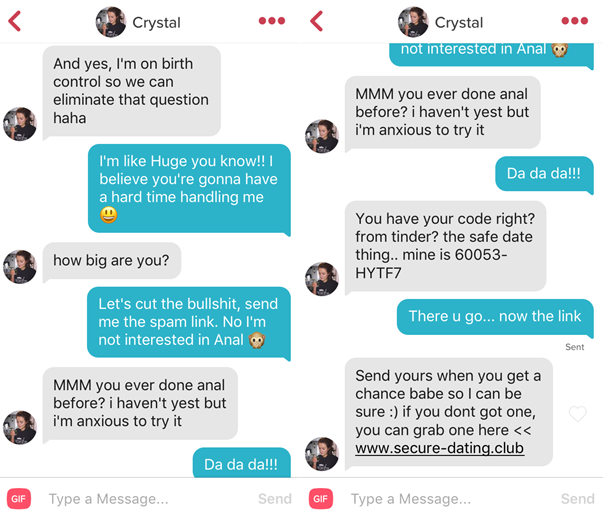- What is the Tinder Code Scam?
- How the Tinder Code Scam Works
- Red Flags of Tinder Verification Scams
- Examples of Tinder Code Scams
- How to Beat This Scam
- Have You Fallen for the Tinder Code Scam?
- Frequently Asked Questions
If you're single, chances are you've used an online dating app at least once in your search for a significant other. Unfortunately, while these apps can be a great way to meet people, scammers use these platforms to con users into giving up their personal information to "verify" their accounts. The Tinder code scam may cost victims nearly $120 a month in auto-enrolled subscription-based memberships.
Tinder Verification Codes Are a Scam
There is no such thing as a Tinder verification code. Tinder does not offer these codes for users, and any request for one is a scam.
What is the Tinder Code Scam?
The Tinder code scam, or "safe dating" scam, is designed to trick users into giving up their credit card info to confirm their identity as a way of building "trust and safety" amongst other users on the platform. Verification options are a much-desired feature on many social media services to legitimize individuals and avoid getting scammed.
Celebrities and public figures are often seen with blue checkmarks alongside their social platforms such as Twitter, TikTok, Facebook, and Instagram, to offer an added layer of credibility. Because of this, scammers are tapping into users' concerns of being catfished by fake profiles, convincing them that becoming verified will lead to a date with a real person.
What makes this scam even more convincing is that Tinder does, in fact, have its own verification service, but this is done in-house directly on the app. Initially rolled out in 2014, the option was only available to notable figures such as celebrities, athletes, and influencers; however, Photo Verification is now available to all users.
How To Safely Verify Your Profile on Tinder
- Open Tinder, tap the profile icon.
- Tap the gray checkmark by your name/age.
- Select 'Verify your profile.'
- You'll be shown a pose. Copy that pose by taking a selfie.
- Confirm that your selfie matches the pose and hit 'Submit for review.'
- Repeat steps 4 & 5 one more time.
The app uses humans and facial recognition technology to authenticate profiles. Once submitted, Tinder will notify you that your account has been verified, and a checkmark will appear on your profile.
How the Tinder Code Scam Works
The Tinder code scam was created as a way to make people feel protected while online dating by providing users with a way to verify whether a profile was real or bogus. Ultimately, the scam works by giving money (or commissions) to scammers per referral—similar to other online affiliate programs that you see on your favorite websites.
Here's how the scam works.
Get a Match…With a Bot
It's a Match! Well, sort of. Once you've matched with a potential date, spambots are used to chat with you using flirty or playful conversation before asking whether you are a verified user or not.

The tricky part about these scams is that scammers often use photos of real people acquired from the internet to be more convincing and authentic. Once you've replied, the bot will try and convince you to verify your profile by saying things like, "hey are you verified by chance? If so whats your code they gave you. Mine is 352-FML0029."
This is followed by, "it's a free service tinder put up, to verify the person you wanna meet isn't a serial killer lol," and will conclude with a fake link including the word Tinder in the URL to appear official.
You Click the Link
Next, if you click the URL, you'll be taken to one of 13 different "Tinder Safe Dating" sites featuring step-by-step instructions on how to get your profile verified.

This may include options such as age confirmation, background checks and a code sent to your phone. Others reference "date codes" to send to your matches to confirm that each person is a verified Tinder user.

To incentivize users, some sites may also feature a picture of a woman in lingerie whose contact information can be acquired following verification. While this may seem like a glaring red flag for some, it's been successful enough for these scammers to continue using similar images over the years.
You Enter Your Information & Your Card Is Charged
To finish the process, you'll be required to provide an email address and create a username and password before submitting your credit card details for a "secure age verification."

Once completed, you will automatically be opted-in to free trials of subscription-based adult websites, which is mentioned only in the fine print. If you don't cancel the subscription within the specified period of time, your credit card will be billed by these sites and can total nearly $120 per month.
Red Flags of Tinder Verification Scams
It's important to be aware of the many ways scammers may try to get information from you using Tinder. According to TechCrunch, a Tinder spokesperson stated the following:
Quote from Tinder SpokespersonTinder will never ask users to verify through a third-party website, download link, or app. Profiles and users promoting any type of third-party verification or requesting personal, financial information and/or payment violate our terms of service, and we have a system in place to remove these profiles from the app. If a user encounters a profile violating our terms, we encourage them to report it immediately within the app.
Reporting a user for spam or inappropriate conduct is straightforward and easy to do. On any given profile, users can tap the ‘3 dots’ icon and select ‘Report.’ From here, Tinder evaluates, takes the necessary action, and removes the inappropriate profile. We also encourage users to review our safety tips, which can be found on our website and accessed through the app.
Nowadays, spambots can be particularly realistic sounding, especially in the online dating world. Users typically offer short, quick responses to messages when chatting with matches which caters to a bot-style way of conversing.
To recognize a Tinder bot, here are some red flags to be on the lookout for:
- Professional or low-quality photos: Be wary of profiles that only contain one to three images, especially if they are low-quality (which may mean they were pulled from the internet) or look like professional modeling shots (these could be stock images).
- Limited info: Profiles with little to no filled-out information may be a sign of a bot. However, this may not always be the case, as some individuals aren't always sure of what to include in their bios.
- Quick responses: Typically, quick responses can point to a bot behind the screen, as they'll often answer faster than a person would actually take to type out a message.
- Requesting a verification code: Tinder does not offer verification codes. Any account requesting one is likely a bot and should be reported.
- Third-party links or downloads: If a user sends a third-party link to click on or asks you to download a link, chances are, it's a fake profile.
Examples of Tinder Code Scams
Spambots can seem surprisingly realistic in conversations on Tinder's messaging platform. You may experience a variety of responses but below are examples of what you may encounter when chatting with a bot.

Typically, bots will exchange pleasantries or flirty messages first before asking you to verify your account. Then they'll let you know it's a free service and tell you they're excited to meet you once you're verified.
Some bots may even use overly-sexual language to convince users to hurry up and get verified in order to meet up for a date or a hookup.

Bots will generally answer easy questions well but can't answer complicated questions. Asking them specific or two-part questions will get nonsensical responses or may be completely ignored.

How to Beat This Scam
If you suspect you may be talking with a Tinder bot, the first thing to do is to stop messaging them and report it. Tinder allows users to report suspicious or offensive behavior within the app for a number of community guideline violations, including:
- Requests for money
- Solicitation or attempts to sell products
- Fraudulent profiles
You can also take a few measures first before reporting them to cover your bases if you're not quite sure of whether a profile is a fake. Consider asking very specific or two-part questions—bots will be unable to answer these types of questions correctly.
Remember, never click on any links sent within the app. Should you accidentally do so, do not give out any personal information being requested and close the page immediately.
Have You Fallen for the Tinder Code Scam?
Unfortunately, mistakes can happen. If you happen to get caught up in the Tinder code scam, here is what you should do to protect yourself:
- Contact your bank
- Update your passwords
- Report fake profiles
- Report the fraud to the authorities
- Protect your credit
- Review Tinder's safety information
Contact Your Bank and Dispute the Charges
If you've entered sensitive financial information into the age verification form, contact your bank or credit card company immediately to let them know. You may need to cancel your card and request a new one.
If any fraudulent charges have been made to your card, dispute them with your bank to have them refunded/reversed.
Update Your Passwords
You'll need to change your Tinder password and update it on any other sites where that same password may have been used. You should use strong and unique passwords for each of your accounts—don't use the same password for more than one account. Use a password manager to help you manage and remember all of your logins.
Report the Fake Profile
Report the fake account to Tinder. Once you report them, they'll be deleted from your matches list and your messages will disappear so it's a good idea to take screenshots for your records before reporting.
Contact the Authorities
Protect Your Credit
If you think you may have had your identity stolen, place a fraud alert or credit freeze on your credit. Recovering from identity theft can take years and cause a lot of stress on your life, so it's crucial to protect your credit as much as you can. Continue to monitor your credit report for suspicious activity that may damage your credit.
Review Tinder's Safety Section
Review the safety section on Tinder's website to help you stay protected while using the app and continue to report any suspicious accounts.


Comments